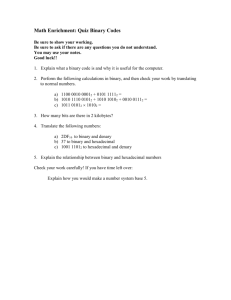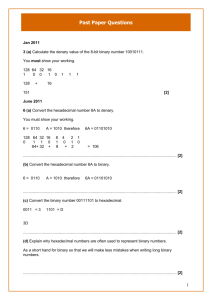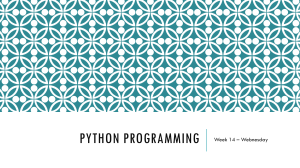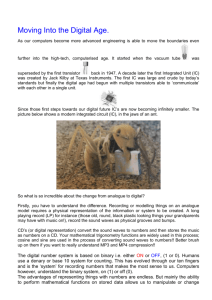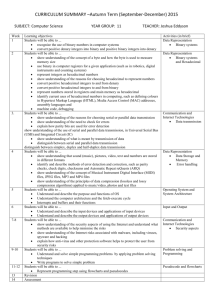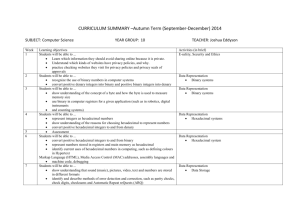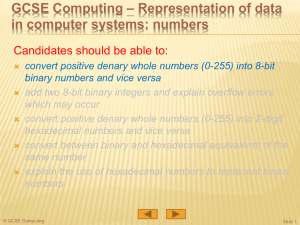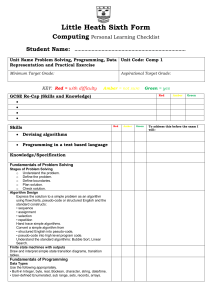GCSE Computing – End of Topic Test Topic 2 – Representation of
advertisement
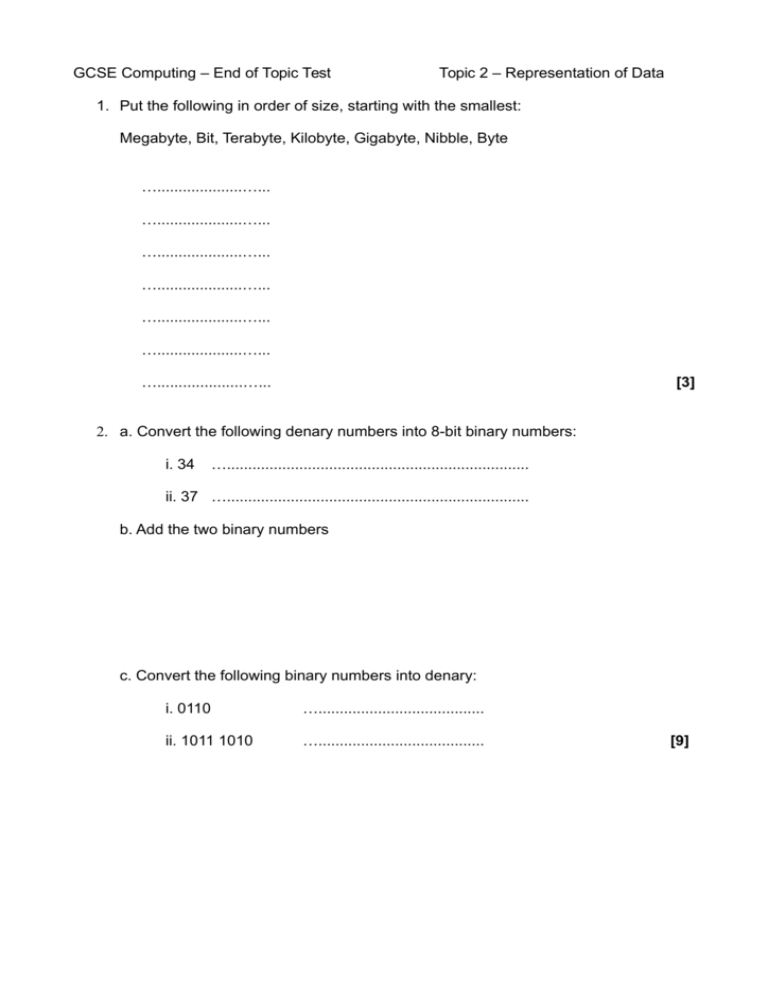
GCSE Computing – End of Topic Test Topic 2 – Representation of Data 1. Put the following in order of size, starting with the smallest: Megabyte, Bit, Terabyte, Kilobyte, Gigabyte, Nibble, Byte …....................…... …....................…... …....................…... …....................…... …....................…... …....................…... …....................…... [3] 2. a. Convert the following denary numbers into 8-bit binary numbers: i. 34 …....................................................................... ii. 37 …....................................................................... b. Add the two binary numbers c. Convert the following binary numbers into denary: i. 0110 …....................................... ii. 1011 1010 …....................................... [9] GCSE Computing – End of Topic Test Topic 2 – Representation of Data 3. a. Convert the following hexadecimal numbers into binary and hence to denary: i. FC Binary: …........................... Denary: …............ Binary: …........................... Denary: …............ ii. 9B b. Convert the following denary numbers into binary and hence to hexadecimal i. 48 Binary: …........................... Hexadecimal: …............ Binary: …........................... Hexadecimal: …............ ii. 165 [16] 4. Explain why hexadecimal is often used instead of denary to represent binary numbers for a human audience. …............................................................................................................................ …............................................................................................................................ …............................................................................................................................ [2] GCSE Computing – End of Topic Test Topic 2 – Representation of Data 5. ASCII is a character set used to map characters to numeric values. ASCII uses 7 bits, providing 128 possible characters. a. How many characters could be represented with an 8 bit character set? …................. b. Which character is represented by the hexadecimal value 56? …................. c. What is the denary representation of the character '@'? …................. d. Some website addresses feature the code '%20'. Looking at the hexadecimal codes above, what does this represent? …................. [5] GCSE Computing – End of Topic Test Topic 2 – Representation of Data 6. Below is a bitmap image. a. Which of the following binary files could be used to represent this image? A) 110 000 011 B) 010 101 010 C) 001 111 100 …............ b. Explain why the file size of the image would be larger if it were it colour. ….................................................................................................................. ….................................................................................................................. ….................................................................................................................. c. As well as colour depth (i.e. how many colours were used), give two other pieces of metadata that could be stored about this image. i. ….......................................................................... ii. ….......................................................................... [5] 7. Rod wants to email a picture to his friend, but the file size is quite large. State two methods he could use to reduce the size of the image file. a. ….................................................................................................................. ….................................................................................................................. b. ….................................................................................................................. ….................................................................................................................. [4] GCSE Computing – End of Topic Test Topic 2 – Representation of Data 8. A concert is recorded by two people, Jane and Freddy. Jane uses a recording device with a sampling rate of 22KHz. Freddy uses a recording device with a sampling rate of 44KHz. a. Describe the difference in file size between Jane and Freddy's recording. ….................................................................................................................. ….................................................................................................................. b. Describe the difference in sound quality between Jane and Freddy's recording. ….................................................................................................................. ….................................................................................................................. [4] 9. Jemma has written a computer program. Briefly explain how the instructions are stored in the computer. ….................................................................................................................. ….................................................................................................................. ….................................................................................................................. ….................................................................................................................. ….................................................................................................................. Total / 50 [2] GCSE Computing – End of Topic Test Topic 2 – Representation of Data Answers: 1. Bit, Nibble, Byte, Kilobyte, Megabyte, Gigabyte, Terabyte (3, -1 for each error) 2. a i. 0010 0010 (1 mark per nibble) 3. 4. 5. 6. 7. 8. 9. a ii. 0010 1011 (1 mark per nibble) b. 0100 1101 (1 mark for answer, 1 mark for working) c i. 6 (1) c ii. 186 (1 mark for each nibble converted correctly) a i. 1111 1100 / 252 (1 mark for each nibble – 4 in total, follow through) a ii. 1001 1011 / 155 (4) b i. 0011 0000 / 30 (1 mark per nibble – 4 in total) b ii. 1010 0101 / A5 (4) Each hexadecimal digit maps exactly to one nibble (1) Two characters map exactly to one byte (1) More efficient / uses less space / uses fewer characters than storing as denary (1) [Max 2] a. 256 (1) b. V (NB: must be capital) (1) c. 64 (1) d. space (2) a. B (1) b. Each pixel requires binary code to represent the colour (1) More possible colours = more bits to represent those colours (1) c. Any 2 of: Height Width Filetype Colour palette Date created (2) Any 2 of | Expansion (1,1) Reduce resolution Reduce colour depth Use more efficient encoding, e.g. JPEG Compression technique, e.g. ZIP a. One smaller than the other (1) Jane's is smaller (1) b. One better quality than the other (1) Freddy's is better (1) Any 2 of: (2) Each instruction converted to binary Binary file stored on the computer (for later retrieval and execution) Each instruction can be retrieved, decoded and executed Other suitable answer
